Menu
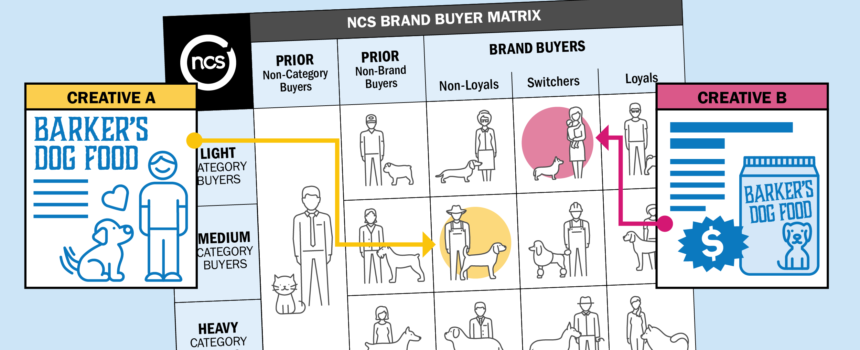
By Steve Tramposch, VP Client Consulting, NCSolutions
MECE.
(Also known as Mutually Exclusive, Collectively Exhaustive.)
MECE isn’t another social media acronym — it’s an advertising effectiveness term. If you’re in the targeting space perhaps you’ve heard of MECE (pronounced “mee-see”). Maybe you vaguely remember the concept from probability in math class long ago, but you can’t imagine exactly how it applies to marketing. We can all probably benefit from a refresher on this term — because understanding the relevance and power of MECE can help us improve our advertising effectiveness throughout a campaign.
Mutually Exclusive
In probability, a set of events is mutually exclusive if they cannot occur at the same time. If you roll a traditional six-sided die once, for example, the set of events 4 and 6 are mutually exclusive because only one of these events can occur at a given time.
Collectively Exhaustive
A set of events is collectively exhaustive if at least one of the events must occur. When rolling the same die, for example, you must get either a 1, 2, 3, 4, 5 or 6 on a given roll — so this set is collectively exhaustive.
When rolling a traditional six-sided die, the events {1,2,3,4,5,6} are both mutually exclusive and collectively exhaustive — they contain no overlaps and no gaps. Are you feeling smarter yet?
What Does This Have to Do with MY Advertising?
When we start to look at people instead of dice, things become a little more complicated. Sure, there are some segmentations that are easy to observe and hence categorize. For example, grouping consumers by age is an example of MECE, because consumers cannot have multiple ages, yet they must have an age that falls somewhere in the 0-75+ range. In contrast, grouping consumers by nationality is not MECE because consumers might have multiple nationalities, or they might not have one at all.
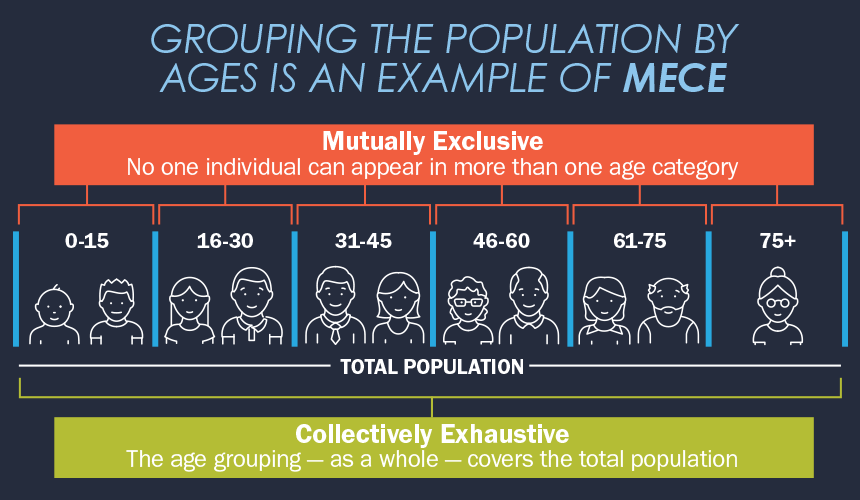
But what about more complicated behaviors, like buying patterns? What makes someone a heavy buyer of dog food, or a heavy brand buyer? Depending on these definitions and the methods used to turn observed data into audience segments, these may be MECE — or they may not.
For Example…
Let’s pretend you’re the manufacturer of a dog food brand. You’re building a marketing campaign in an effort to get people who sometimes buy your brand (and sometimes buy a competitor’s) to switch to your brand.
You don’t want to show your ad to someone who doesn’t own a dog — because that would be a waste of ad dollars. You also message differently to your non-loyal buyers than you do to your brand switchers — so you want to make sure that the consumers who see this ad campaign are indeed brand switchers.
My colleague Lance Brothers, Chief Revenue Officer of NCSolutions says it well: the best message–if it’s not delivered to the right person–it’s not going to be effective.
At NCS, we take all this observable data and behavior and create our 13-cell grid. It gives advertisers the ability to plan messaging for specific groups, and to test that messaging while the campaign is in-flight. If you’re focused on brand switchers in your ad campaign, you could isolate your targets to the three boxes in the switchers column.
Consumers are divided along two dimensions — the degree to which they buy in a given category (heavy, medium, light and non-category buyers), as well as their degree of loyalty to a particular brand (loyals, switchers, non-loyals, non-brand buyers). This brand buyer matrix is an example of a MECE framework because any consumer must fit into one of these 13 boxes, and they cannot fall into more than one box at a given time.
If we didn’t have a strong MECE framework, the edges between groups would be blurry, and marketers wouldn’t know who exactly saw which ad, or how to attribute the sales results. That’s why MECE is important. While many consumer segments out there don’t follow a MECE framework, at NCS we believe it’s crucial to targeting.
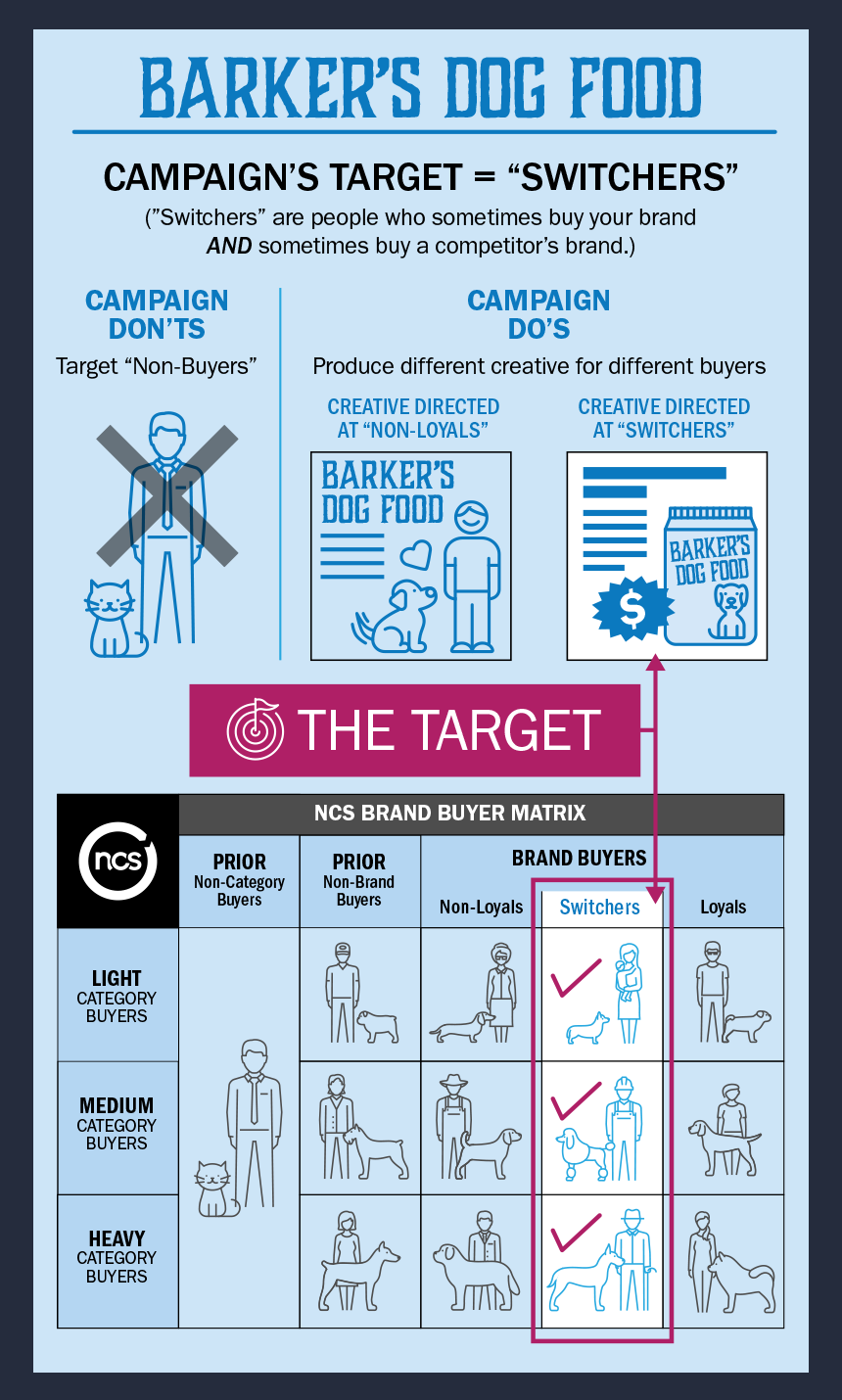
Why this matters for…
…Planning
When selecting your campaign targets, it is critical to limit the overlap between consumers with no shifting, so the lines are clear and crisp.
…Mid-campaign
The precision offered by MECE segments provides more power to in-flight optimization. In the past, if a marketer wanted to adjust an ad campaign mid-flight to target a different segment, the marketer would have to rerun the segment data. Today, we use a MECE framework that prevents buyers from switching segments mid-campaign. Moreover, if you test two creatives with two different segments, you can have greater confidence that these ads will not be seen by someone in another segment.
…Post-campaign
Cleaner segments mean more accurate and meaningful post-campaign measurements. The cleaner your segments, the more you know exactly who saw which ad, and the more confident you can be that a target consumer really did buy your dog food brand because they saw your ad.
Got more questions on MECE? Learn more about how a MECE framework can make your advertising campaigns more effective.
Subscribe for Updates
GET INSIDE THE MINDS OF CPG BRAND MARKETERS
Learn about their data-fueled strategies
SNAG YOUR COPY OF THE REPORT TODAY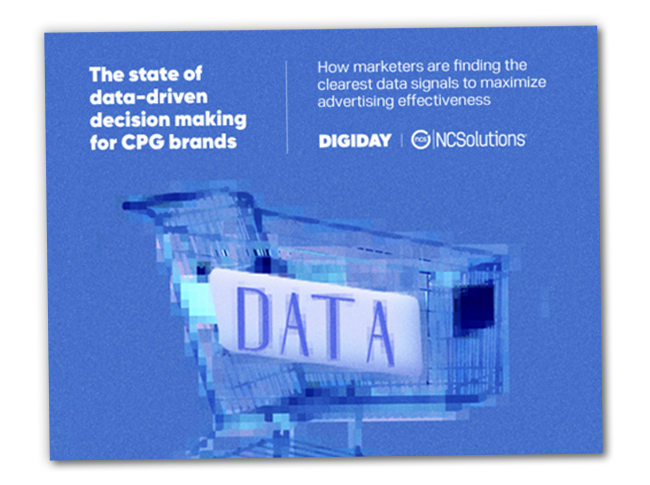
WONDERING HOW CONSUMERS RESPOND TO INFLUENCER MARKETING?
See how creating content drives results
DOWNLOAD YOUR COPY NOW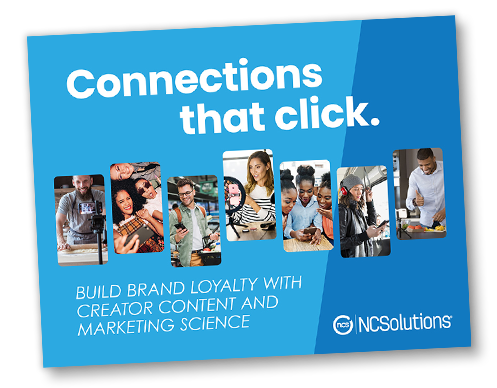
WANT TO KNOW MORE ABOUT HEALTH AND ECO-MINDED SHOPPERS?
Get CPG insights to engage your buyers
ACCESS THE E-BOOK TODAY


.png)
.png)

